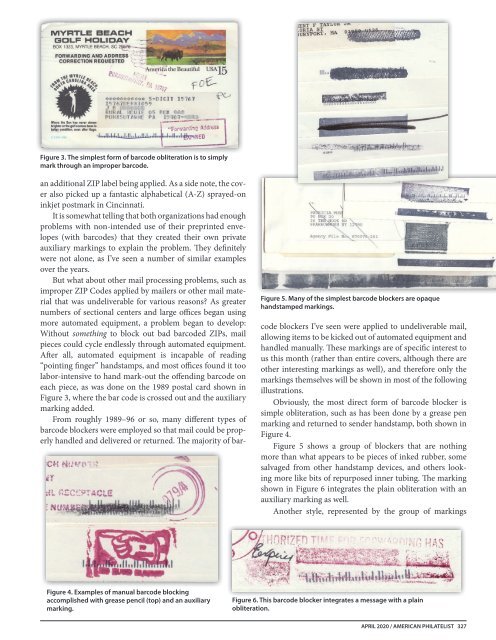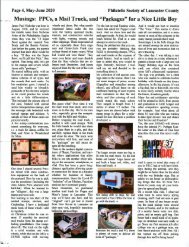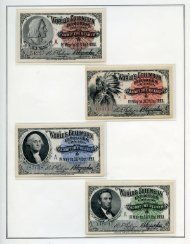The American Philatelist April 2020
Holocaust Rememberance Issue
Holocaust Rememberance Issue
Create successful ePaper yourself
Turn your PDF publications into a flip-book with our unique Google optimized e-Paper software.
Figure 3. <strong>The</strong> simplest form of barcode obliteration is to simply<br />
mark through an improper barcode.<br />
Figure 5. Many of the simplest barcode blockers are opaque<br />
handstamped markings.<br />
an additional ZIP label being applied. As a side note, the cover<br />
also picked up a fantastic alphabetical (A-Z) sprayed-on<br />
inkjet postmark in Cincinnati.<br />
It is somewhat telling that both organizations had enough<br />
problems with non-intended use of their preprinted envelopes<br />
(with barcodes) that they created their own private<br />
auxiliary markings to explain the problem. <strong>The</strong>y definitely<br />
were not alone, as I’ve seen a number of similar examples<br />
over the years.<br />
But what about other mail processing problems, such as<br />
improper ZIP Codes applied by mailers or other mail material<br />
that was undeliverable for various reasons? As greater<br />
numbers of sectional centers and large offices began using<br />
more automated equipment, a problem began to develop:<br />
Without something to block out bad barcoded ZIPs, mail<br />
pieces could cycle endlessly through automated equipment.<br />
After all, automated equipment is incapable of reading<br />
“pointing finger” handstamps, and most offices found it too<br />
labor-intensive to hand mark-out the offending barcode on<br />
each piece, as was done on the 1989 postal card shown in<br />
Figure 3, where the bar code is crossed out and the auxiliary<br />
marking added.<br />
From roughly 1989–96 or so, many different types of<br />
barcode blockers were employed so that mail could be properly<br />
handled and delivered or returned. <strong>The</strong> majority of barcode<br />
blockers I’ve seen were applied to undeliverable mail,<br />
allowing items to be kicked out of automated equipment and<br />
handled manually. <strong>The</strong>se markings are of specific interest to<br />
us this month (rather than entire covers, although there are<br />
other interesting markings as well), and therefore only the<br />
markings themselves will be shown in most of the following<br />
illustrations.<br />
Obviously, the most direct form of barcode blocker is<br />
simple obliteration, such as has been done by a grease pen<br />
marking and returned to sender handstamp, both shown in<br />
Figure 4.<br />
Figure 5 shows a group of blockers that are nothing<br />
more than what appears to be pieces of inked rubber, some<br />
salvaged from other handstamp devices, and others looking<br />
more like bits of repurposed inner tubing. <strong>The</strong> marking<br />
shown in Figure 6 integrates the plain obliteration with an<br />
auxiliary marking as well.<br />
Another style, represented by the group of markings<br />
Figure 4. Examples of manual barcode blocking<br />
accomplished with grease pencil (top) and an auxiliary<br />
marking.<br />
Figure 6. This barcode blocker integrates a message with a plain<br />
obliteration.<br />
APRIL <strong>2020</strong> / AMERICAN PHILATELIST 327

















